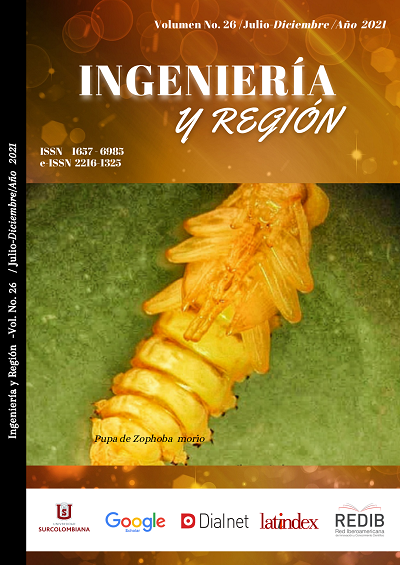Determinación del carbono orgánico por el método químico y por calcinación
##plugins.themes.bootstrap3.article.main##
La materia orgánica es un parámetro importante, que se utiliza como indicador de calidad del suelo y está relacionado directamente con las propiedades físicas, químicas y biológicas del suelo. Además su cuantificación se requiere para recomendar la cantidad y el tipo de enmiendas que se debe aplicar al suelo. En el presente artículo se compararon dos procedimientos para cuantificar este parámetro. El primero se hizo determinando la materia orgánica por un método químico de la norma NTC 5403 oxidación húmeda propuesto por Walkley y Black en 1934. El segundo método utilizado fue por calcinación llevando las muestras a una mufla por un periodo de dos horas a 360 °C y obteniendo los valores por diferencias de peso. Se compararon las muestras encontrando una alta correlación entre los dos métodos con un coeficiente de determinación de 0.902. Lo anterior indica que se puede obtener los contenidos de materia orgánica por calcinación ahorrando tiempo y recursos, pues su determinación está relacionada con el contenido de humedad del suelo, la densidad aparente y la calidad del suelo.
Descargas
##plugins.themes.bootstrap3.article.details##
Andriulo Adrián E. & Irizar Alicia B. 2017. La materia orgánica como indicador base de calidad del suelo. Manual de indicadores de calidad del suelo para las ecorregiones de Argentina Marcelo G. Wilson ... [et al.]. - 1a ed. Entre Ríos: Ediciones INTA, 2017. Libro digital, PDF. ISBN 978-987-521-826-0
Arrieche, I., Pacheco Y., 1998. Determination of Organic Carbon In Soil Samples Using Two Analytical Methods. Fondo Nacional de Investigaciones Agropecuarias del Estado Yaracuy. Volumen 6 N. 12.
Beke, G. L., McCormick, M. J., 1985. Predicting volumetric water retention for subsoil materials from Colchester County, Nova Scotia. Can. J. Soil Sci. 65, p 233-236. https://doi.org/10.4141/cjss85-026
Bell, A. M., Van-Keulen, H., 1995. Soil pedotransfer functions for four Mexican soils. Soil Sci. Soc. Am. J. 59, p 865-871. https://doi.org/10.2136/sssaj1995.03615995005900030034x
Cargua Catagña, F.; Rodríguez Llerena, M.; Damián Carrión, D.; Recalde Moreno, C. y Guido Patricio Santillán Lima. 2015. Analytical methods comparison for soil organic carbon determination in Andean Forest of Sangay National Park-Ecuador. Acta Agron. (2017) 66 (3) p 408-413 ISSN 0120-2812 | e-ISSN 2323-0118. https://doi.org/10.15446/acag.v66n3.52467.
De Jong, R., 1983. Soil water desorption curves estimated from limited data. Can. J. Soil Sci. 63, p. 697-703. https://doi.org/10.4141/cjss83-071
Eyherabide, M., Saínz-Rozas, H., Barbieri, P., Echeverría, H., 2014. Comparación de Métodos para Determinar Carbono Orgánico en Suelo. Ciencia del Suelo. Asociación Argentina de la Ciencia del Suelo. 32(1): p 13-19.
FAO. 2019. Mapa de Carbono orgánico del suelo. http://www.fao.org/3/i8195es/I8195ES.pdf
Hudson, B. D., 1994. Soil organic matter and available water capacity. Journal Soil Water Conserv. 49. p 189 – 194.
Instituto Geográfico Agustín Codazzi. (IGAC)., 2003. Estudio General de Suelos, Evaluación y Zonificación de las Tierra del Departamento del Amazonas. p 340
Martínez H, Eduardo; Fuentes E, Juan Pablo y Acevedo H, Edmundo. Carbono Orgánico y Propiedades del Suelo. R.C. Suelo Nutr. Veg. [online]. 2008, vol.8, n.1 [citado 2020-08-08], pp.68-96. Disponible en: <https://scielo.conicyt.cl/scielo.php?script=sci_arttext&pid=S0718-27912008000100006&lng=es&nrm=iso>. ISSN 0718-2791. http://dx.doi.org/10.4067/S0718-27912008000100006.
McBride, R. A., MacIntosh, E.E., 1984. Soil survey interpretations from water retention data: 1. Development and validation of a water retention model. Soil Sci. Soc. Am. J. 48, p. 1338-1343. https://doi.org/10.2136/sssaj1984.03615995004800060028x
Ordóñez, M., Bravo, I., Figueroa, A., 2013. Flujo de Carbono Orgánico Total (COT) en una cuenca andina: caso subcuenca Río Las Piedras. Revista Ingenierías Universidad de Medellín, vol. 13, No. 24. p. 29- 42 https://doi.org/10.22395/rium.v13n24a2
Pachepsky, Y., Rawls, W.J., 2004. Development of pedotransfer functions in soil hydrology. Developments in Soil Science Vol. 30. Editors book. Elsevier Science.
Pardo-Plaza, Y.J.; Paolini Gómez, J.E.; Cantero-Guevara, M.E., 2019. Microbial biomass and basal soil respiration under agroforestry systems with coff ee crops. Rev. U.D.C.A Actualidad & Divulgación Científica. Volumen 22 No. 1:e1144 https://doi.org/10.31910/rudca.v22.n1.2019.1144
Rawls, W.J., Pachepsky, Y.A., Ritchie, J.C., Sobecki, T.M., Bloodworth, H., 2003. Effect of soil organic carbon on soil water retention. Geoderma. p 116, 61-76. https://doi.org/10.1016/s0016-7061(03)00094-6
Riley, H.C.F., 1979. Relationship between soil moisture holding properties and soil texture, organic matter content, and bulk density. Agric. Res. Exp. 30, p. 379-398.
Salamanca, A., Sadeghian, S., 2005. La densidad aparente y su relación con otras propiedades en suelos de la zona cafetera Colombiana. Cenicafé, vol 56. p 381 – 397.
Soil Survey Laboratory Methods Manual., 2002. Methods for the Determination of Total Organic Carbon (TOC) in Soil and Sediments. U.S.Environmental Protection Agency. Exposure Research Laboratory. Las Vegas.
Soil Survey Staff., 2014 Kellogg Soil Survey Laboratory Methods Manual. Soil Survey Investigations Report No. 42, Version 5.0. R. Burt and Soil Survey Staff (ed.). U.S. Department of Agriculture, Natural Resources Conservation Service.
Villa, J., Tobón, C., 2012. Modeling hydrologic dynamics of a created wetland, Colombia. Elsevier. Ecological Engineering. vol. 40, p. 173-182. https://doi.org/10.1016/j.ecoleng.2011.12.005
Walkley, A., 1947. A critical examination of a rapid method for determining organic carbon m soils: Effect of variations in digestion conditions and of inorganic soil constituents. Soil Sci. 63:251-263. https://doi.org/10.1097/00010694-194704000-00001
Walkley, A., I.A. Black., 1934. An examination of the Degtjareff method for determining organic carbon in soils: Effect of variations in digestion conditions and of inorganic soil constituents. Soil Sci. 63:251-263. DOI: 10.1097/00010694-193401000-00003
Wolf, B., Snyder, G., 2003. Susteinable soils; the place of organic matter in sustainable soils and their productivity. New York. Food Products Press. p. 352


















